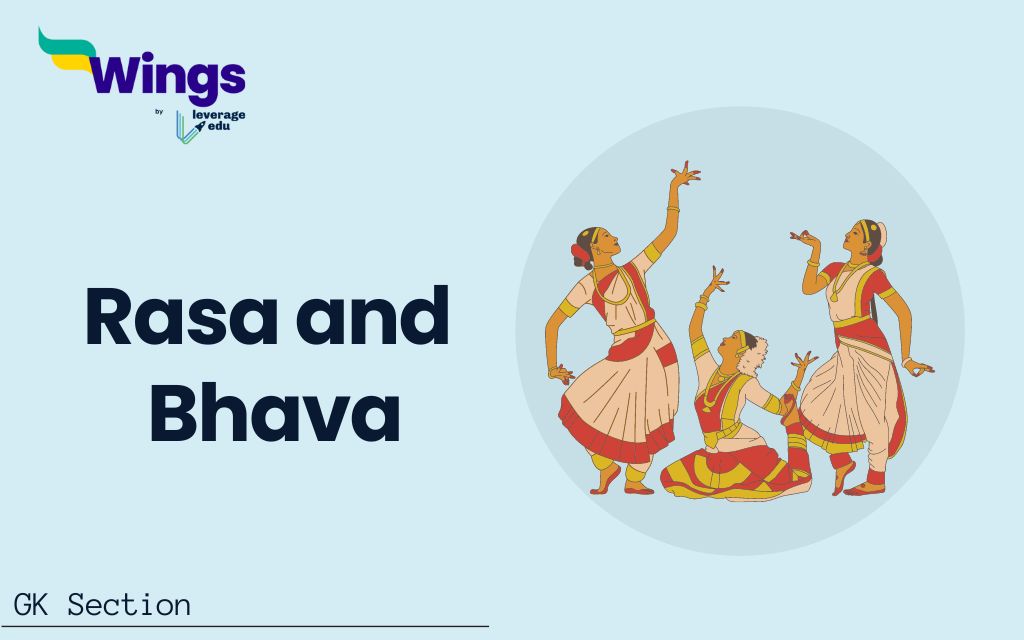Rasa and Bhava have a relationship as performers and spectators. Rasa-Bhava is the central concept behind Indian performing arts, including dance, drama, cinema, and literature. Bhava is a state of mind, while Rasa is the result of Bhava. Both of these terms come from Natyasastra, a work by sage Bharata Muni written between 200 BCE and 200 CE. In this blog, we will look at the concepts of Rasa and Bhava and their significance in Indian classical art. It will help you understand the fundamental principles of performing art. This is also a potential topic that can appear in the art and culture section of various competitive examinations such as UPSC, SSC, and EPFO.
Contents
What is Rasa?
Rasa is a Sanskrit word that means ‘essence’. In Indian art, it refers to an artist’s emotional impact on its audience. This concept is important to those who seek to evoke emotions in their viewers or audience. According to the Natyasastra, there are mainly nine Rasas, also known as Navarasas. These Rasas are mentioned below.
- Sringara (Romantic Love): This Rasa is associated with love, beauty, and attraction, which depicts the emotions related to love.
- Hasya (Humor): The Rasa of Laughter reflects joy.
- Karuna (Compassion): THis Rasa evokes pity and sorrow, reflecting on the characters’ suffering.
- Raudra (Anger): This Rasa is associated with anger and violence. Intense and aggressive emotions characterize it.
- Vira (Heroic): This is the Rasa of heroism and Courage. It portrays strength, bravery, and confidence.
- Bhayanaka (Terror): This Rasa is associated with fear and anxiety. It often depicts scenes of danger and horror.
- Bibhatsa (Disgust): This Rasa is related to things that are unpleasant, impure, or ugly.
- Adbhuta (Wonder): This is the Rasa of amazement and curiosity. t reflects the sense of wonder and surprise.
- Santa (Peace): This Rasa is associated with serenity and calmness. It is the expression of a peaceful mind.
Also Read: List of Indian Classical Dances
What is Bhava?
Bhava refers to the emotional situation that leads to Rasa. Rasa is the experience, while Bhava is the emotion that causes the experience. Bhava is the raw emotion, whereas Rasa is the pure essence.According to the Natyasastra, there are eight primary Bhavas, as listed below.
- Rati (Love): The emotional state associated with love and affection, leading to the Rasa of Sringara.
- Hasa (Laughter): This is the emotional state of laughter and joy that leads to the Rasa of Hasya.
- Soka (Sorrow): This is the emotional state associated with sadness which leads to the Rasa of Karuna.
- Krodha (Anger): This emotional state is of anger and rage, leading to the Rasa of Raudra.
- Utsaha (Excitement): The emotional state associated with energy which leads to the Rasa of Vira.
- Bhaya (Fear): This is the emotional state of fear that leads to Rasa of Bhayanaka.
- Jugupsa (Disgust): This emotional state is related to the feeling of disgust, leading to the Rasa of Bibhatsa.
- VIsmaya (Surprise): The emotional state associated with wonder and amazement, leading to the Rasa of Adbhuta.
The Relationship Between Rasa and Bhava
The link between Rasa and Bhava is inter-connected. Bhava is the cause, and Rasa is the effect. In the theatre, the performer expresses Bhava through their art, evoking Rasa (emotion) in the audience.

- The ability of the performer to awaken the Rasa through the portrayal of Bhavas defines the success of an artistic performance.
- In classical Indian dance, the Bhava of sadness is represented through facial expressions and gestures.
- Only when this Bhava is successfully expressed, then the audience experience the Rasa.
- Rasa and Bhava’s relationship contributes to a strong emotional connection with the performance.
Also Read: Hindustani And Carnatic Music
Application of Rasa and BHava in Various Art Forms
The presence of Rasa and Bhava in various art forms such as literature, dance, music, and theatre shows its impact on ancient India.
- In Literature: Poets and authors use Rasa and Bhava to evoke emotions through the written word. It is entirely dependent on the choice of words that leads to the formation of Rasas.
- In Theatre: The entire structure of the theatre, every element, from the screenplay and conversation to the acting and stage design, is carefully chosen to enhance the audience’s emotional journey.
- In Dance: Classical Indian dance traditions such as Bharatanatyam, Kathak, and Odissi are based on the concepts of Rasa and Bhava. Dancers use facial expressions to evoke emotion in the audience.
- In Music: In Indian classical music, Rasa is created by combining melody and rhythm to produce the desired emotional reaction from the listener.
Related Posts
FAQs
In Indian classical music, Rasa is created by combining melody and rhythm to produce the desired emotional reaction from the listener.
The Bhakti movement originated primarily in South India by Alvaras and Nayanars. Rasa is a Sanskrit word which means ‘essence’. In Indian art, it refers to the emotional impact that an artist has on its audience. This concept is important to those who seek to evoke emotions in their viewers or audience.
The nine rasas are Sringara, Hasya, Karuna, Raudra, Vira, Bhayanaka, Bibhatsa, Adbhuta and Santa
This was all about the “Rasa and Bhava”. For more such informative blogs, check out our UPSC Exams Section and Study Material Section, or you can learn more about us by visiting our Indian exams page.
 One app for all your study abroad needs
One app for all your study abroad needs














